A shrike present on Long Island NY October-November 2010 was originally (and understandably) identified as a Northern. it received wider attention after Shai Mitra questioned the ID in late November, and for several days generated quite a bit of debate over its identification. Most concurred that it was a Loggerhead, but the reasons were mostly subjective or vague, and many people were led astray by details such as bill color that are unreliable. Shrike identification seems relatively simple, but when a bird like this comes along it forces us to ask the question “How can we know that’s a Loggerhead?”
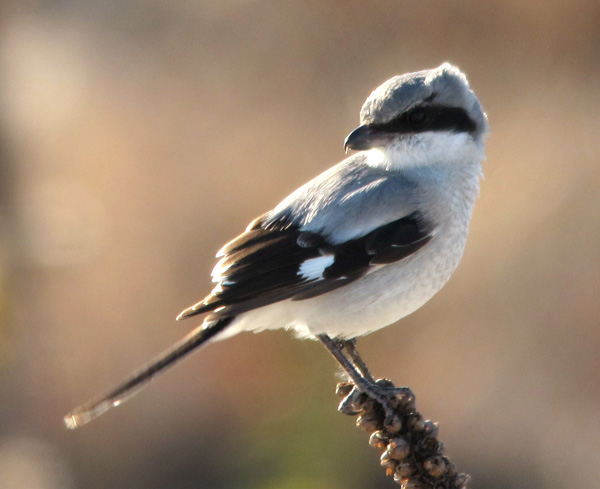
Some good shrike identification references are:
Pittaway and King here http://www.ofo.ca/site/page/view/articles.shrikeid
McGowan here http://www.birds.cornell.edu/crows/loggerhd.htm
This is not a frequent identification issue. The two species of shrikes are usually widely separated by range and season, and identification of most individuals is fairly straightforward. The fact that most Northern Shrikes wandering south of their normal range are immatures, which are the most distinctive in appearance, gives us a false sense of security. When an adult Northern comes along it can appear confusingly similar to Loggerhead, and – it turns out – especially similar to immature Loggerhead.
Since immature Northerns are so distinctive, with a narrow and incomplete dark mask, little white at the base of the primaries, and more or less extensive (but extremely variable) brown wash, we can immediately rule that out for the Long Island bird. The debate over the Long Island bird comes down to adult Northern vs. immature Loggerhead.
For the Long Island shrike, the pale tips on the greater coverts mark it as an immature. Adults have uniform glossy black wing coverts forming an unbroken expanse of black on the forewing. Since it’s an immature, it can only be a Loggerhead, regardless of the pale bill, barred breast, and impressions of shape or habits. The photo below shows details of the identification.
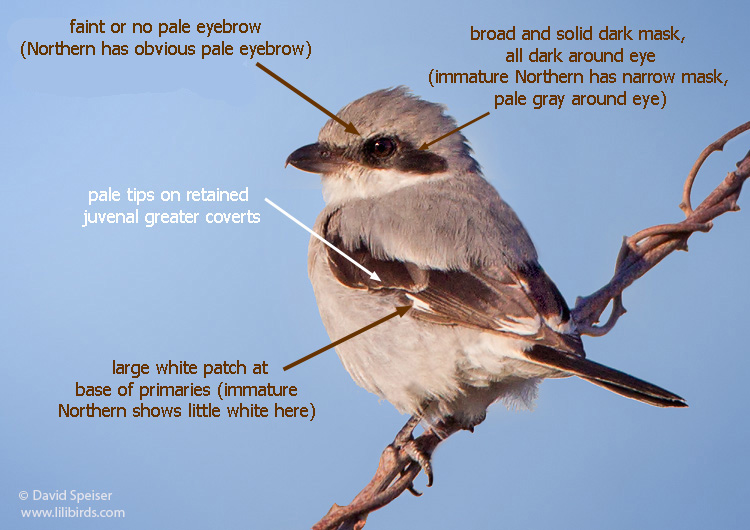
One feature that seems quite useful for identifying the Long Island bird is the lack of a pale band above the black mask. Loggerheads often show the dark gray crown coming right down to the black mask, as on the Long Island bird. Many show a narrow and fairly distinct white line somewhere over the eye. Northerns generally show a broad paler band all the way along the edge of the crown, and continuing across the forehead.
Now to discuss some of those things that are less helpful for identifying the Long Island bird, sort of organized from most useful to least:
- Overall shape
This is generally very useful for shrike ID, and it’s one point where most people agreed: the Long Island bird has the “large-headed, round-bodied, short-billed, and cute” appearance of a Loggerhead. In fact, Shai Mitra reports that his first suspicion that this bird could be a Loggerhead was based on the overall shape. The problem, of course, is that shape is variable and hard to desribe. We can get an impression from the bird, and we may feel very confident about that, but for an identification that will satisfy a records committee we need something more concrete.
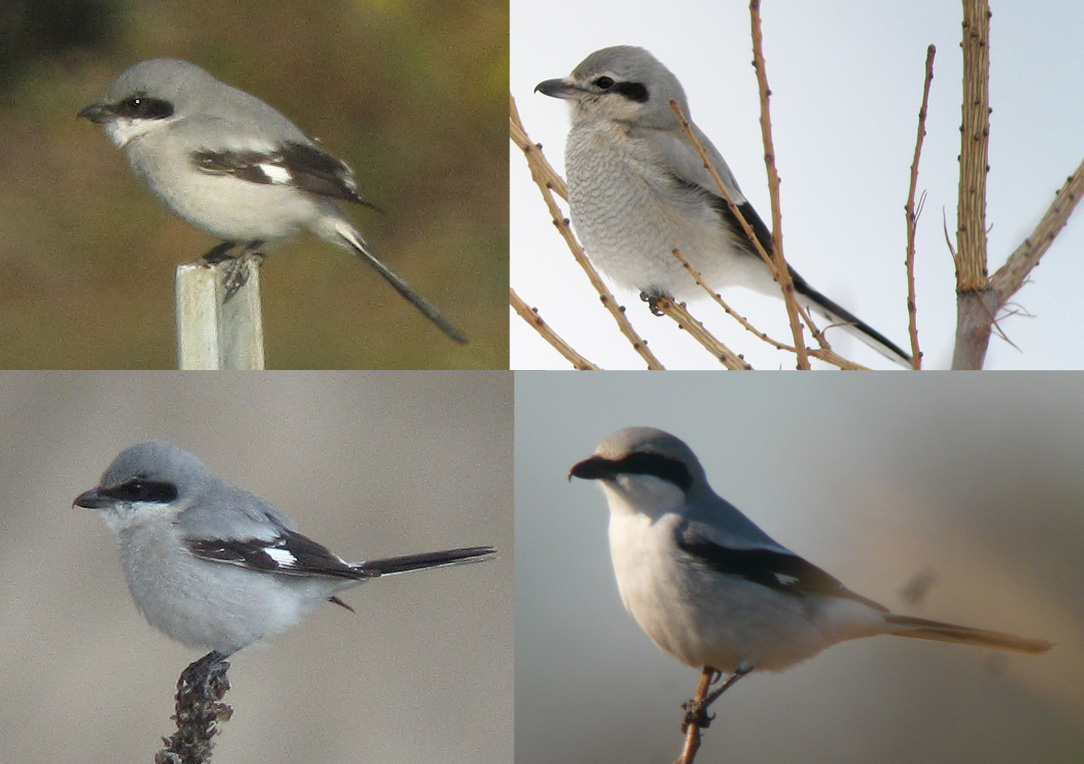
- Shade of gray on the back
This is distinctly darker on Loggerhead, darkest on the crown and with the crown much darker than the breast. Northern has paler upperparts, with the difference between breast and crown less obvious. But… shades of gray are notoriously difficult to judge in the field and in photos, so without direct comparison or a lot of experience this should be used with caution.
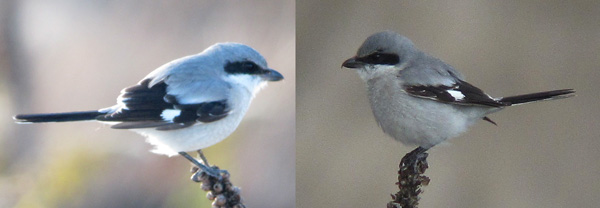
- Shape of black mask
Loggerheads often have a broader black mask than Northern, very different from immature Northern, but adult Northerns can be very similar. In that case Loggerheads often have more black on the forehead and more black just behind and above the eye, but some Loggerheads are gray on the forehead and some Northerns have black behind the eye. Each of these might work as “one-way” field marks: a shrike with black across the forehead has to be a Loggerhead and a shrike with no black just behind the eye has to be a Northern, but this requires more testing.
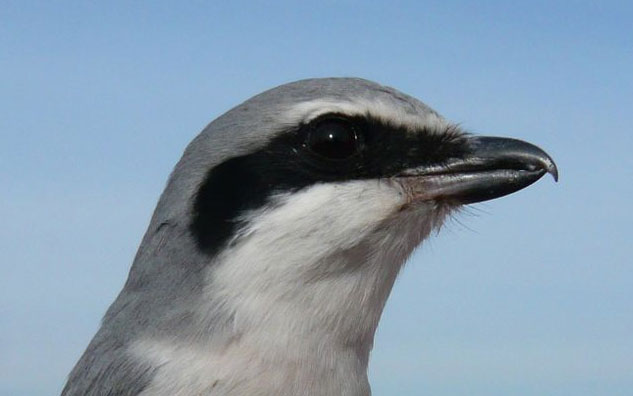
- More hooked bill
Northern is often touted as having a more strongly-hooked bill, and while there is a difference in overall bill size and length (shown well in Kevin McGowan’s photos here), any difference in bill hook is too subtle and variable to be much use in the field.
- Pale-based lower mandible
Several people commented on ID-Frontiers the fact that Loggerheads, especially juveniles, can have a pale base of the lower mandible. Susan Craig further suggested that all Loggerheads develop a pale base in winter. This feature seems essentially useless. Few people see Northern Shrikes in summer, so one question to ask is “Do Northerns have all dark bills in summer as well?”
- Barred breast
Conspicuous on most Northern Shrikes (some adults show no barring at all, as in the Maryland bird show above) and on juvenal-plumaged Loggerheads. One of the questions raised by the Long Island shrike is whether barring can still appear in the first post-juvenile plumage of Loggerhead Shrike, and the answer is an unequivocal yes. Not all first-winter Loggerheads show barring, the barring is usually less obvious than on Northerns, and it probably wears off quickly, but the Long Island bird is well within the norm for Loggerhead.
Thanks to the photographers, follow the links for more shrike photos:
Shaibal Mitra – http://picasaweb.google.com/tixbirdz/LongIslandMiscellany2010#5545719853661351474
John Gluth – http://www.flickr.com/photos/jgluth_brb/5212944267/in/set-72157625379326695/
David Speiser – http://www.lilibirds.com/gallery2/v/recent_work/
Dan Small – http://picasaweb.google.com/small.m.dan/20082010ChinoNSHR?feat=directlink#


David,
The answer is yes to the question “Do Northerns have all dark bills in summer as well?” The Birds of Canada (Godfrey 1986) on page 450 says, “Breeding adults of both species have an all-black bill”. Northerns acquire an entirely black bill as early as mid March according to Zimmerman in Wilson Bulletin 67(3):200-208, 1955. In southern Ontario, Loggerhead and Northern Shrikes are the most difficult to distinguish in late March and April when both species overlap. Occasional Northerns linger into May. Identification is further complicated in spring and summer when Northern Shrikes are often clear breasted because the vermiculations below have worn off. Northern Shrikes breed in the Hudson Bay Lowlands of northern Ontario. Ontario has a small breeding population of Loggerhead Shrikes with most now concentrated on the Carden Alvar east of Lake Simcoe about 75 miles (125 km) northeast of Toronto.
Ron
Thanks for this Ron. So I guess Northerns just average slightly paler-billed than Loggerheads in winter. And presumably the birds with the palest bills are immature Northerns, which are already easy to identify by mask pattern.
If you are interested, I have a few pictures of a Loggerhead that has taken up residence in our neighborhood in northeastern, NC. He has been in the area since Sept. 27th. I have a set on Flickr at: http://www.flickr.com/photos/kenskritters/sets/72157625354991722/
Ken Christison
Thanks Ken, that is a great collection of photos.
One field mark that I’ve noticed on Loggerhead Shrikes that I don’t see mentioned here is that Loggerhead Shrikes have a white throat, but a gray breast which ends abruptly at the throat and forms a sharp contrast with the throat. Northern Shrikes (at least, adults anyway) have a white throat that blends well into the breast and color difference between the two is barely noticeable if at all.
Have you noticed this on Loggerhead Shrikes? or is this something that Northern Shrike can display as well?
Thanks Chris, I have noticed this at times but thought it was too subtle to put much emphasis on, and there were times when I’ve seen each species that seemed to show the pattern of the other, but it may be more reliable than that. Geographic variation could also play a role, if Loggerhead Shrikes (for example in California) average a little darker on the breast, that would make the white throat stand out more. In what region do you see this?
I recently found this article while searching for shrike ID pages. I saw a shrike this morning here in NE Ohio.
The first reference link needs to be updated. The Pittaway and King site is now here:
http://www.ofo.ca/site/page/view/articles.shrikeid
Thanks Ken, it’s updated now.
Is it possible for a juvenile Northern Shrike in central Alberta to be a dark enough brown to be close to black? I have a friend who has described a bird that could be a juvenile except it sounds too dark. Unfortunately she could not get a photo. She also thinks it was closer to 7 inches. Any ideas would be appreciated.
Pingback: January Quiz: Answer | Mountain Plover